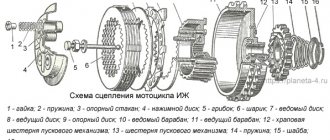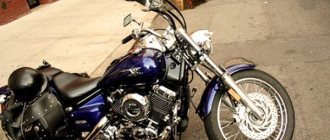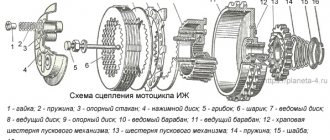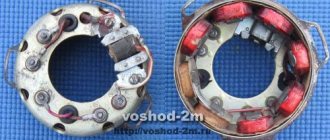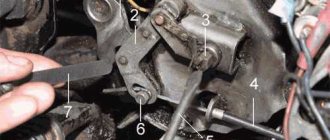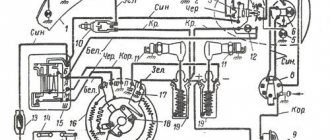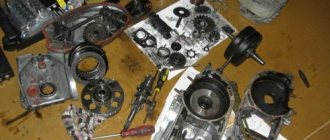A motorcycle clutch is a serious unit that transmits torque from the engine to the rear wheel drive (gearbox). In part, it is classified as consumables, since it needs to be changed regularly. On the other hand, this mechanism requires precise tuning and the ability to control the bike, which can significantly extend its service life.
The principle of operation of the clutch basket
To understand how the clutch works, it is necessary to study the general structure of the assembly. It consists of the following elements:
- Clutch basket, connected on the outside to the crankshaft, and on the inside to the gearbox input shaft;
- Friction and metal discs;
- Springs that provide compression of the discs without slipping.
The principle of operation of the mechanism is based on the force of friction and sliding between clutch discs, friction and metal, which alternate with each other. Friction ones have a rough surface, metal ones have a smooth surface. When they are firmly compressed by springs, they transmit torque from the engine to the gearbox. When the clutch is depressed, the discs move away from each other and do not touch, so rotation is not transmitted.
Car device
The clutch actuator is used for remote control of the clutch. The most widespread are mechanical and hydraulic drives.
The use of a particular drive on a car is determined by the type of clutch, the layout of the car and a number of requirements to ensure ease and convenience of control. Thus, the full travel of the clutch pedal should not exceed 190 mm, and the pedal force should not exceed 150 N for a passenger car and 250 N for a truck. Therefore, the total gear ratio in existing clutch drive designs ranges from 25 to 50. If a higher gear ratio is needed to ensure the clutch operates, amplifiers of various types are used.
***
Mechanical clutch drive
A mechanical clutch drive is simple in design and reliable in operation, but has lower efficiency compared to a hydraulic drive, since a lot of energy is lost in the articulated joints of the rods and levers that make up the drive, and in the shells of flexible shafts due to friction forces. Therefore, this type of drive is usually used if the clutch is located close to the controls (clutch pedal).
There are cable and lever mechanical clutch drives.
Cable drive (Fig. 1, a) is used on passenger front-wheel drive cars. The pedal 14 has an upper support on the bracket 16 and is connected to the tip 10 of the cable. The cable is enclosed in a sheath 1 having two ends. The upper tip 12 of the shell is brought into the car interior and rests against the thrust plate 11, and the lower tip 2 of the shell is fixed in the bracket 3 on the clutch housing. The lower tip 5 of the cable is connected through a leash 8 to the lever 9 of the clutch release fork. The pedal stroke is adjusted using washers 6.
When you press the clutch pedal, the cable moves inside the sheath and moves the clutch release fork lever, which subsequently acts on the clutch release clutch.
The lever drive of a truck (Fig. 1, b) ensures the transmission of force to the clutch when it is turned off as follows. When the pedal 14, attached to the shaft 20, is acted upon, the lever 18 connected to the opposite end of the shaft rotates. The shaft lever moves the rod 19 attached to it on the axis, which is connected to the lever 17 of the clutch release fork. The clutch release clutch, pressed against it by a spring, moves together with the fork. After selecting the gap between the clutch release bearing and the levers, the clutch will begin to disengage.
The clearance in the clutch should be 3...4 mm, which corresponds to 35...50 mm of free play of the clutch pedal. The gap is adjusted by changing the length of the rod 19 (Fig. 1) using the adjusting nut 22. The absence of a gap or its insufficient value in a drive of this design can lead to incomplete engagement of the clutch and, as a result, to clutch slipping. Increasing the gap beyond the norm leads to incomplete disengagement of the clutch, resulting in noise and crackling of the gears when changing gears.
***
How to understand that the clutch has become unusable?
The power of the bike and the safety of riding it depend on the setting and condition of the clutch. Every motorcyclist can understand for himself that it’s time to change the unit:
- The clutch is slipping. This is easy to check. It is necessary to accelerate to medium speed in 3-4 gears, and then sharply unscrew the throttle. If the revolutions increase, but the speed does not increase proportionally with them, it means there are problems, the discs are slipping. Either they need to be changed, or the springs need to be adjusted, or attention to the entire basket is needed. Also often the reason lies in low-quality or already outdated oil;
- Mot is trying to drive with first gear engaged and the clutch depressed. Normally, no cravings should be felt. If you have to stop the bike with your feet, then there is a problem with the clutch. Most often this is deformation of metal discs or a breakdown in the squeeze line. Requires disassembly of the unit and careful inspection.
Engine and power system on motorcycles
Without any alteration, the following can be considered interchangeable: carburetors, piston rings, connecting rod upper end bushings, piston pin and its retaining rings, valve springs and their retainers, as well as all clutch parts except the flywheel. Conventionally, the pistons can also be considered interchangeable, but in the case of installing KMZ pistons on a Ural motorcycle, you will have to cut the skirt (for example, along the lower oil scraper ring). Complete engines are also interchangeable, but together with the “original” exhaust pipes.
Transmission.
The driven gear, speedometer drive gear and some bearings are interchangeable (see tables in the appendix). And it’s best to rearrange the gearbox assembly - here almost everything fits fine - some nuances arise with the driveshafts. The fact is that the “Ural” checkpoint is shorter than the “Dneprovskaya”. There are probably not many people who want to install an Irbit gearbox on KMZ motorcycles, and in order to install a gearbox from the Dnepr on a Ural, you must either replace the “native” cardan with a shorter one, from the M61 or M62, or use the assembly from the KMZ - seats on the shanks are identical. I’ll even note that the Dnieper box will be a little better than the Ural box.
Final drive (“axle”) on motorcycles
Despite the different external shapes and slight differences in the drive of the brake pads, the axles are interchangeable. Problems with the number and diameter of studs securing the main gear to the pendulum can be solved quite simply with the help of a drill and taps. All parts hidden inside the “bridge” are also interchangeable, although they may have slight differences depending on the age of the unit. In the case of installing a “Dnepr” “bridge” on a “Ural” motorcycle, a rear wheel from a “Dnepr” may also be required, since the “Ural” wheel is multi-spoke and can rub the brake drum against the fist.
Chassis.
The front telescopic forks and spring-hydraulic suspension elements of the rear wheel and sidecar wheels are absolutely identical on motorcycles. These units are interchangeable both as a whole and in small details. But you need to avoid the combination of a “Ural” wheel with a stamped brake drum and “Dnieper” brake shields; the reverse combination is absolutely workable. If we consider the wheel as a set of parts, then the rim and all the insides of the hub can be considered the same: bearings, spacers and nuts with oil seals.
Electrical components on motorcycles can be considered absolutely identical: a generator, a relay regulator, a breaker with an automatic advancer, an ignition coil, as well as all lighting equipment and switches on the handlebars.
They are different in shape, but have the same seats: a gas tank, a front fender, a double saddle (you will need to rotate the saddle lock on the frame 180°), a steering wheel with fasteners and a stroller awning.
Sidecars on motorcycles fit quite normally from one motorcycle to another (after all, the fasteners are the same), except that you can adjust the traction a little! Although I’ll interject again: I have an old-style frame on the K-750 and the Ural sidecar was positioned a little incorrectly - the motorcycle stood at an angle from the sidecar, so I had to shorten the rear link a little (the adjusting bolt was not enough, it was screwed in all the way). Trimmed it a little, welded it - now it stands like its own! By the way, I like the Ural strollers better - the MT strollers are uncomfortable and there is no separate luggage compartment in the back!)))))
Source
Working the clutch correctly
The clutch mechanism is needed not only to change gears. Moreover, professional racers do not use a clutch to change gears at all. This node also gives you the following options:
- By squeezing the clutch, you can abruptly break the connection between the engine and the wheel in the case of, for example, an engine wedge. This will prevent you from falling;
- Depressing the clutch during emergency braking allows you to slow down as much as possible without letting the engine stall. After which you can return the traction to the wheel to perform an evasive maneuver;
- Maneuvering at low speeds is ensured by proper clutch operation.
How to operate the clutch correctly to control the bike at minimum speeds? The principle is to find the so-called “gray zone”, when the disks are not fully compressed or decompressed. They provide partial grip, but still slip.
In this case, the gas is kept at medium speed, and the speed is controlled by the clutch and rear brake. This ensures a smooth ride of the motorcycle, it does not jerk when there is a lack of traction, and does not fall over when turning. This is the easiest way to pass the training ground when passing for category A. This is how you pass the most difficult elements of gymkhana.
The clutch is your best friend and perhaps the main control element of your motorcycle. It is important to be able to work with this unit correctly, care for it and change it in a timely manner.
Couple-uncouple
Transmission. Part 2. Clutch and quickshifter
Text: Artem 'S1LvER' Terekhov
Any motorcycle must be able to disconnect the crankshaft drive from the rear wheel so that the engine can run when the bike is stationary. Despite this obvious statement, imagine this possibility did not always exist.
Many early motorcycles used direct drive via a belt and pulleys on the crankshaft and rear wheel that could not be separated. This drive really worked, but some problems arose during its operation. For example, to stop at an intersection, you had to turn off the engine. And in this case, it was possible to start the bike only from the pusher, which is clearly not the best starting option. The clutch mechanism was designed to ensure that the running engine is decoupled from driving the rear wheel. The second function, no less important, is the ability to select gear ratios on machines that are equipped with a gearbox. Let's see how this mechanism works. Clutch principle Clutch operation is based on friction. In its simplest form, the clutch consists of two discs, one of which is located on the crankshaft journal, and the second is connected through some drive mechanism (chain, belt, gears) to the rear wheel and is pressed against the first disc. If there is a small gap between the disks, the engine runs while the second disk remains motionless. If you connect the disks to each other, the rotation of the crankshaft due to friction will be transmitted to the second disk, and since it is connected to the rear wheel, it will also rotate. So the power supply from the engine to the wheel can be switched on or off as needed. The vast majority of modern production bikes use a manually operated clutch from a lever located on the handlebars. The exception is scooters that use an automatic centrifugal clutch, the operating mode of which depends on engine speed. Our article will focus specifically on the clutch that is used on motorcycles (unfortunately, the format of the article does not allow us to laugh enough at funny stories about scooter riders who switched to motorcycles and try to “brake” with the clutch). How the clutch works The entire clutch assembly is installed on the input shaft of the gearbox (read about the structure of this device in our article). housing or outer drum is mounted on a bearing and can rotate freely and independently of the shaft. The outer clutch drum is directly connected through the forward gear to the crankshaft (although there are also designs in which the clutch is mounted directly on the crankshaft journal; this arrangement is common on motorcycles made by BMW and Moto Guzzi), so that when the crankshaft rotates, it also rotates. The central part of the clutch, or inner drum (hub), is smaller and is located inside the outer drum. It is installed on the input shaft of the gearbox and is secured against rotation by splines, so that when the inner drum rotates, the input shaft also rotates.
Section of a multi-plate clutch in an oil bath, Yamaha R6 2008
The clutch discs are located in the space between the outer and inner drums. Two types of discs are used: smooth and friction. They are arranged alternately, and the exact number of discs depends on the type of clutch and the machine on which it is used. On the outer circumference of the friction discs there are rectangular splines that are installed in the grooves of the outer clutch drum. On the inner circumference of the smooth discs, teeth are cut, which are installed in the grooves of the inner clutch drum. In the normal position (when the bike is in motion), the friction and smooth plates are held in direct contact by springs acting on a plate called the pressure plate . When the crankshaft and outer clutch drum rotate, due to the friction that occurs between the plates, the inner clutch drum, and therefore the transmission input shaft, also rotates. When the rider squeezes the clutch lever, the cable or hydraulic mechanism, counteracting the force of the springs, pushes the pressure plate away from the pack of smooth and friction plates, causing the discs to no longer touch. By eliminating direct contact between the discs, friction is reduced, allowing the outer drum to rotate freely relative to the inner drum. As the rider releases the clutch lever, the discs are pressed against each other again, and gradually the rotation of the outer clutch drum due to friction begins to be transferred to the inner drum, thus gradually transmitting torque to the gearbox and further to the rear wheel; this eliminates the possibility of stopping or jerking (of course, if you do everything correctly and release the clutch smoothly). The ability of the clutch to transmit torque depends on many factors: the number and diameter of the discs, the force of the springs compressing them, and the coefficient of friction between the discs. All other things being equal, smaller machines require fewer disks than large, powerful machines. Likewise, if the torque is the same, then by increasing the diameter of the disks their number can be reduced. Friction discs (who would have thought?) have friction material applied to them, while smooth discs are made of steel.
2007 Honda CBR1000RR Clutch Components
Design matters When choosing the type of clutch to be installed on a particular motorcycle, several determining factors influence the designer's decision. First, let's look at the number of disks. A multi-plate clutch uses more than one set of smooth and friction discs, usually seven or eight, and sometimes nine friction discs are used. There are always one fewer smooth discs compared to friction discs, since the disc package is always limited on both sides by friction discs. On most monoblock engines (that is, those in which all transmission components are located within the engine crankcase) with a transverse crankshaft in the frame, a multi-plate clutch is used. The reason for this is the small clutch diameter. A multi-disc clutch is also much lighter than a single-disc clutch, although it has a larger friction surface and strength. Single- or double-plate clutches are used on motorcycles with a longitudinal crankshaft in the frame (for example, Moto Guzzi bikes with a V-twin, the cylinders of which are located across the frame). The clutch is mounted on the rear journal of the crankshaft and has a separate housing between the engine and gearbox. Because of this arrangement, the clutch does not need to be compact, and with large diameters only one or two discs are needed. The next question that designers decide is to use a dry clutch or one operating in an oil bath.
Ducati 749 dry clutch on display (covered in stock, of course)
It may seem strange that a mechanism whose principle is based on friction should operate in oil; but there are several important reasons for this. The oil acts as a heat dissipator to prevent the clutch from burning. In addition, it serves as a lubricant for the bushings or bearings on which the outer clutch drum rotates, and also facilitates the movement of splines and disc teeth. An additional “bonus” of an oil bath clutch is that to ensure lubrication of the front gear, you do not need to seal the clutch in a separate chamber. You can’t go against physics - naturally, the friction provided between the clutch discs operating in an oil bath is lower than the friction between the dry clutch discs. Therefore, large-diameter disks or a larger number of them are required (or perhaps both), which leads to increased dimensions.
Suzuki RGV250 equipped with dry clutch
The same RGV250, but with an oil bath clutch
This is why dry clutches are mainly used on sports bikes. High efficiency and low weight (no need to pour oil) are an integral part of a dry clutch. However, the same as a small resource. Most racing machines are equipped with a dry clutch, as are almost all civilian Ducati sportbikes (except for the 848, but there is a separate one for it). Japanese manufacturers mainly use oil bath clutches. From a practical point of view, a “wet” clutch looks preferable - a much longer service life and less tendency to overheat. On the other hand, if the goal is maximum performance in a race, then the choice will be in favor of a dry clutch.
Nothing is broken here, this chirping sound is the sound of a working dry Ducati clutch
Another point that the designer must decide is how the force from the lever will be transmitted to the clutch drive mechanism. Most often, a cable is chosen for this purpose, otherwise a mechanical clutch drive . Cables are subject to stretching and wear, and require adjustment and lubrication, but are easy to maintain and repair. The mechanical drive is simple - the cable acts on the clutch through a drive mechanism located inside the clutch cover or on the opposite side of the crankcase, while the mechanism acts on a long pusher passing through the input shaft of the gearbox. The hydraulic clutch drive mechanism is used mainly on large-volume machines. It costs much more and requires careful maintenance, but the shortcomings are more than offset by the smoothness and ease of its operation. The hydraulic drive operates on the same principle as the front brake system (we will also talk about brake systems in due course): when the lever presses on the master cylinder plunger, it acts on the hydraulic fluid and forces it into the hose. The fluid then pushes the piston of the working cylinder, which acts on a pushrod located inside the input shaft. Other than regularly checking the fluid level, the hydraulic system requires little to no maintenance, although fluid and seals must be replaced periodically to keep it functioning properly. Also, the design of any hydraulic system implies that the fluid is prone to absorbing water and becoming saturated with air (in short, servicing the hydraulic clutch is similar in care to servicing the brake system). With that out of the way, let's move on to more modern and high-tech stuff. I think that while reading reviews of modern motorcycles, you have repeatedly come across the phrase “slipper clutch.” As a rule, the presence of it on the motorcycle being tested delights the tester, which he immediately reports. However, no one really explains how this thing works. Let's start with this. Slippery type The slipper mechanism in the clutch (hereinafter referred to as PS for simplicity) is a development aimed at high-performance motorcycles. The main goal for the PS is to limit the reverse torque that appears when braking the engine from high speed or when changing to lower gears. For the first time, the PS was used on a drag bike of the 70s under the name Hogslayer - a non-trivial clutch for that time allowed the “Pig Killer” to accelerate to 290 km/h without slipping or overheating (in addition, two 880 cc injection engines contributed to this maximum speed from Norton, but that's a completely different story...). Among modern production motorcycles, the slipper clutch has also found its place - mainly, it is equipped with sportbikes, as well as charged factory street bikes.
Slipper clutch for Ducati 999 from FBF
Now let’s take a closer look at why PS is used in general. When the gas is opened, the rear wheel is driven through the clutch. When the throttle is closed and the bike continues to move at a speed higher than the set limit corresponding to the current throttle opening, the rear wheel is still turning the engine shaft through the clutch; but because the engine offers a lot of drag (due to compression, especially at high speeds and lower gears), it is possible to reach a point where the drag, or back-torque, of the engine exceeds the rear tire's coefficient of adhesion. The result of this is a locked rear wheel. This outcome is especially likely in rainy conditions, because... in the rain, the coefficient of adhesion between the tire and the road is greatly reduced, and the weight redistribution that occurs during sudden braking reduces the load on the rear axle. PS is installed in order to eliminate the possibility of wheel locking due to clutch slipping when changing the direction of torque transmission. However, the PS does not disengage the clutch completely, and the engine braking effect remains. Different manufacturers approach the design of the clutch in different ways, but most often slippage is ensured by the following mechanism: the inner clutch drum is located on a series of ratchet stops with an inclined surface. When the direction of torque transmission changes, the inner clutch drum moves on the ratchet stops, thereby retracting the pressure plate and relieving pressure on the discs. This approach was commercially tested for the first time on the Kawasaki ZXR 750.
2007 Kawasaki ZX-6R Slipper Clutch - Standard
Aprilia engineers took a more complex and technological path when designing the RSV Mille clutch. To move the inner clutch drum, a servomotor is used, which is controlled by a vacuum supplied from the engine intake manifold. When the throttle is closed, the increased vacuum in the manifold creates a vacuum in the air line of the servomotor, which shifts the inner clutch drum and relieves pressure on the discs. This approach is no longer used anywhere except RSV; manufacturers prefer a simpler option, tested on the ZXR 750 (each company tries to bring something different to the PS design, but the general principle remains very similar to the Kawasaki version). Whatever one may say, despite its simplicity, the slipping mechanism in the clutch is a very, very useful thing. If your motorcycle is not equipped with PS, do not despair, it is likely that a tuning kit for it exists in nature, you just need to look for it. Quickshifter Finally, we got to the long-awaited topic - the Translogic quickshifter systems, also known as BMW Quickshifter. Contrary to the sensational statements of the German company about the new super technology, such systems of “quick gear shifting without the rider releasing the clutch”, produced by some tuning companies, the most famous of which are Translogic and Dynojet, have long been used by participants in the World Superbike, Supermoto/MX and even go-karts It's just that BMW was the first company to decide to install this system in some production bikes.
The advantage of the mechanism is inherent in its very name: “quick” - “fast”, “shift” - “shift, displacement, switching”. That is, “quickshifter” literally translates as “quick switch”. How quickly do the gears change, you ask? The answer can be found in the example given on the official Translogic page. “The most professional motorcycle racer takes at least 340 milliseconds to change gear, while Translogic systems require 48 to 150 milliseconds.” Impressive, isn't it? Another technology that came down from the Olympus of big-time motorsport and became accessible to “mere mortal” motorcyclists.
DynoJet QuickShifter Kit
Now let’s look at the “quick click” device. The key elements of the entire mechanism: a pressure sensor (monitors the pressure on the gear shift foot; simply put, it determines whether the rider presses it or not) and a quickshifter rod (if the standard one does not fit). Some manufacturers (for example, Dynojet) also offer a quickshifter on/off button that can be mounted on the steering wheel. The sensor is connected to an external ignition control module (for example, Power Commander). When the rider puts pressure on the gear shift paw, the sensor sends a signal to the ignition control module, after which it instructs the ECU to temporarily turn off the ignition (for a few tens of milliseconds). When the engine is turned off, switching occurs - without releasing the gas or squeezing the clutch. In the case of BMW motorcycles, there is no need to buy an ignition control unit - the quickshifter is connected to the original “brains”, nothing needs to be adjusted or installed. Usually a quickshifter is installed when they want to improve the acceleration dynamics of the device, but nothing prevents you from shifting down in the same way when braking.
*****
I hope that by reading this article you have made some further progress in understanding what a motorcycle is. However, a lot of ironclad questions have not yet been solved, so stay tuned, there are many interesting topics for discussion ahead!
